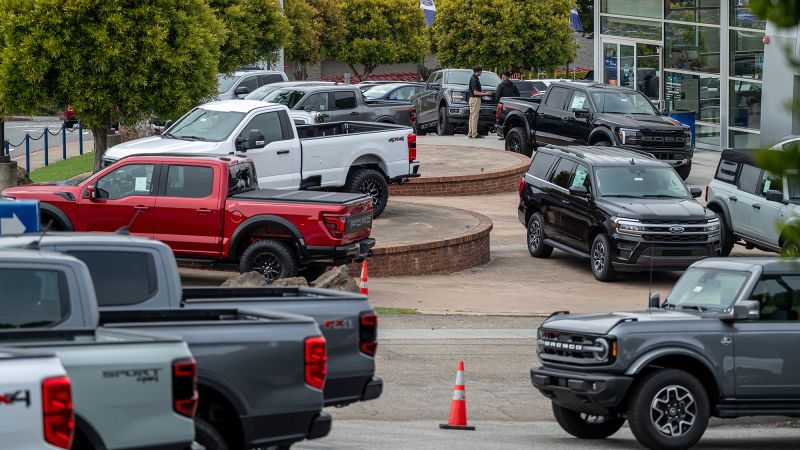new york
CNN
—
It’s called sticker shock. And if you haven’t been to a dealer showroom before the pandemic, you might want to be prepared.
Americans paid a whopping $47,612 on average for a new car in October, according to Edmunds data. This is an increase of nearly $10,000 from pre-pandemic October 2019. This means that the price of new cars has risen much faster than most goods and services.
The rise in prices has multiple origins. The pandemic has disrupted supply chains and restricted essential car parts. Buyers increasingly prefer larger vehicles with more features, continuing a decades-long shift toward larger and more expensive SUVs and trucks.
But a lot of the reason Americans are paying nearly $50,000 for cars is because automakers decided to put all their efforts into expensive cars. The more expensive the car, the more money you can make from it.
“You’d be hard-pressed to find anything from an American automaker for less than $30,000,” says Ivan Drury, director of insights at Edmunds. “They’re completely hacking away at models and basic trim levels that are no longer a big part of their business. They’re raising the floor price.”
Today’s cars are equipped with all kinds of driver assistance features, including automatic braking, adaptive cruise control, and blind spot warning systems.
“People didn’t realize they wanted[these features]until they had them,” said Charlie Chesbrough, economist and senior director of industry insights at Cox Automotive. “It’s a combination of what consumers want and where the industry is moving. The market is abandoning the sub-$35,000 price point.”
Electric cars are also on the rise, and demand for hybrid cars is increasing, but both are more expensive than traditional gasoline-only cars.
The remaining cheap cars are usually foreign brands. The average price of a Nissan vehicle sold in the U.S. in the third quarter was $35,362, which includes sales of the company’s luxury Infiniti brand.
The traditional Big Three — General Motors, Ford and Stellantis, which sell under the Jeep, Ram, Dodge and Chrysler brands — have effectively abandoned the sedan market and focused almost entirely on SUVs and pickup trucks.
Ford only sells one traditional “car” these days. The Mustang is a two-door coupe, not a family sedan. The last non-SUV or pickup Chevrolet will roll off the line this month.
By excluding almost everything except large, comfortable crossovers and SUVs, average selling prices are already $50,922 for GM, $54,963 for Stellantis, and $55,632 for Ford. It’s rising.
The average price is $142 lower than it was a year ago, but it is likely to rise further in the near future.
Drury said that’s because high interest rates have kept prices down for the past several years. Buyers are having to spend more on their auto loans after the Federal Reserve raised interest rates to a 20-year high to combat inflation. Interest rates are lower now, so you have more cash to spend on expensive features instead.
Average interest rates on new car loans (7% in October) are well above where they were at the beginning of the pandemic. The average monthly car payment rose to $742 in October due to higher interest rates, higher car prices, and the average loan taken out to purchase a car was at an all-time high.
“The only thing that has stopped rates from rising further is interest rates,” Drury said.
“If money had been a little cheaper, we probably would have hit $50,000 by now,” he says. “If they can buy more cars rather than spend more money on financing, they will do it.”
Prices could also rise further if President-elect Donald Trump makes good on his threat to impose hefty tariffs on imports, particularly in the auto sector.
Details are still unclear, but even if the tariffs are limited to complete cars, they could reduce competition from lower-priced foreign models and increase the price of cars produced in U.S. factories. said Jeff Schuster, global vice president of automotive research at consultancy GlobalData.
Additionally, many of the cheaper models available in U.S. showrooms are imported here from overseas or Mexican factories.
Tariffs may also be imposed on auto parts. And because no car is made with 100% American parts, all cars built in the United States will be more expensive.
“Those costs are passed on to car buyers; they are not absorbed by car manufacturers or suppliers,” he said.



